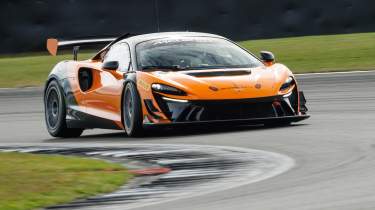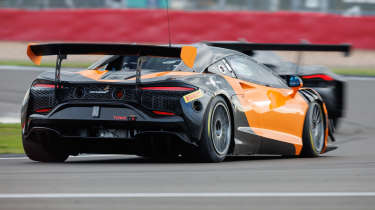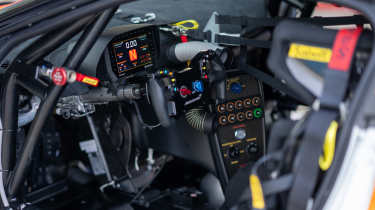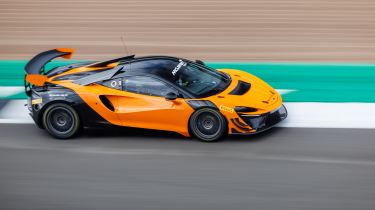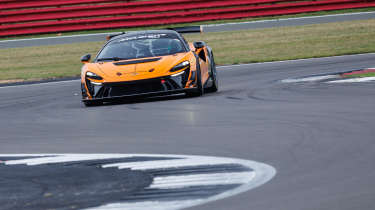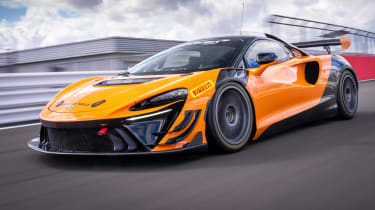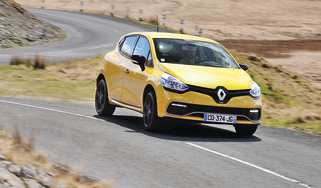McLaren Artura Trophy Evo 2025 review – Woking's race-spec supercar is a riot
McLaren’s one-make-race-series Artura has evolved, with more of everything: grip, aero and attitude. As it turns out, it’s riotously good fun, too
Putting the word ‘Evo’ on the end of a car’s name is invariably a sign that it’s something special – of course. Take the new McLaren Artura Trophy Evo: this is one of the most joyously thrilling racing/track cars I’ve ever driven. And not just because it has an excellent name.
The original, non-Evo McLaren Artura Trophy was launched for the 2023 season: a racing version of the Artura road car, conceived to compete in its own one-make McLaren Trophy race series but also with the option to be converted with minimal effort into a GT4 racing car, eligible for various national and international championships around the world.
> Now’s the time for McLaren to show us what it can really do
This new Evo version is an evolution in the truest sense of the word, with a comprehensive set of updates to make the Artura racer a more potent and more unique experience than before. It makes its racing debut in 2025; as its development concluded in 2024, we got behind the wheel at Silverstone to find out how it feels first-hand.
This time there’s less crossover with the Artura GT4 racing car: McLaren had intended the capability for customers to compete in both the McLaren Trophy and GT4 competitions using the same car to be a key attribute but, as it transpired, few took the opportunity. So, freed from the need for the car to be easily converted into GT4 spec, McLaren’s engineers have unshackled the Trophy car, making it faster and giving it a more distinctive character of its own.
Firstly, McLaren wanted the Trophy to look more dramatic. The GT racing market is similar to the roadgoing supercar market in some ways, in that many customers might choose a car with more visual presence over a more subtly styled one. Compared with, for example, a Lamborghini Huracán Trofeo car, all vents, angles and aggression, the Artura Trophy was arguably on the meek side for a racing supercar. The Evo has been made wider, with a much greater – and more imposing – frontal area. The tyres have grown wider too, to 285mm at the front and 315mm at the rear, compared with the previous Trophy car’s 265mm and 305mm. Even from a distance, the Evo’s tracks are visually broader than its predecessor, and the large overlapping louvres slashed into its front wheelarches add some attitude too (as well as subtracting some lift, and aiding cooling). Perhaps its most distinctive design feature from the outside is its pair of buttress scoops channelling air from the roof down through the rear wheelarches to cool the brakes. Aside from the extra visual impact and mechanical grip from its broader footprint and extra rubber on the ground, the additional surface area helps give the Evo greater downforce, too.
More reviews
Predictably, it’s also more powerful than the previous car, with 612bhp of peak power compared with the original Trophy’s 577bhp. Rather than just give drivers another chunk of horsepower and be done with it, however, McLaren has made it a strategic feature. A new Push-to-Pass (P2P) system gives drivers the full 612bhp Monty if they push and hold a button on the top-left of the cut-down, F1-style steering wheel. The rest of the time, the engine delivers its standard 577bhp. However, there’s a limit of 300 seconds. Since the McLaren Trophy series has the option for two drivers to share a car (there are three categories: for two Silver-grade Pro drivers sharing, a Silver/Bronze Pro/Am combo, or solo Bronze drivers) they’ll need to make some key decisions: do they use most of the extra power early in a race to build a lead, or at the end to defend? And if there’s a safety car, will all that early time be wasted? In a Pro/Am pairing, should the Pro leave the lion’s share of the allocation to the Am driver?
Power comes from the same dry-sump 3-litre twin turbo V6 as the Artura road car. The racing car isn’t a hybrid, however; that’s not currently permitted in GT4 racing, and the Trophy still shares much of its DNA with the GT4 car. The extra space where the battery would normally reside is taken up by the repositioned oil tank and extra fuel tank space for the race-spec fuel safety cell.
We sample the Artura Evo during a Pure McLaren trackday – the entire Grand Prix circuit reserved privately for McLaren customers in all kinds of pinnacle machinery: including Senna GTRs, the derestricted 720S GT3X track special and even several Solus GTs, with their wailing naturally aspirated V10s.
McLaren factory driver Rob Bell talks us through the Evo’s controls: The seat is fixed in position; pull a lever to your right and the spring-loaded pedals come to you. Once you’ve got them in a comfy position, let go of the handle and they’re locked in place. When Bell fires the V6, there’s an audible schwurp sound as air is sucked greedily through the body’s side scoops. Like the road car, the V6 isn’t the prettiest of sounds on the ear but it does have its own distinctive, powerful note.
Our turn to climb aboard. Looking around you, you can see more of the Artura’s composite structure than is usually visible in the road car. It looks almost organic, like an alien structure.
It's perfectly simple to pull away – like the road car, it’s a dual-clutch transmission (an unusual cocktail in this car of the 570 GT4’s seven-speed gearbox – including reverse, taken care of by the electric motor on the hybrid Artura road car – the 675LT’s final drive and a race-spec mechanical limited-slip differential), so you just click a paddle, take your foot off the brake pedal and go.
I take it relatively easy initially as I acclimatise to the Evo’s performance. I haven’t driven the original Artura Trophy but I have competed in a race in its 570 GT4 predecessor, and the Artura feels noticeably more responsive. Even at moderate speeds as the tyres come up to temperature, the Evo is a very positive car, giving you more in return for your inputs than the 570. The nose responds instantly and accurately to a smooth arc of the steering wheel, and it’s clear the Artura is keen to get going, and wants to be hustled along.
Pushing harder, it comes alive. Stability in Silverstone’s high-speed corners is thoroughly impressive, and addictive, as the aero comes into play. But the McLaren impresses in lower-speed corners too: its balance is predictable, and it’s a neutral car. New billet uprights have unlocked more precise brake feel, Bell says, and stiffer anti-roll bars and new two-way adjustable dampers together with the wider track have boosted traction and stability.
At the very limit, the Artura does lean a little toward stable understeer but this is in its out-of-the-box baseline set-up – you could dial in pointier, ‘on-the-nose’ handling with some adjustments as you chase lap times. Set up as is, the Evo doesn’t have any obvious handling vices, and invites you – incites you, almost – to overdrive it a little. Which isn’t always fast but is invariably fun.
However you choose to drive the Trophy Evo, it feels seriously fast. The original Artura Trophy was already a quick car, capable of lapping close to GT3 pace (since the cars racing in the McLaren Trophy aren’t subject to GT4 racing’s usual Balance of Performance restrictions, the Artura is faster in Trophy spec than in GT4 spec). The Evo is faster than ever. Trying out the P2P system is an interesting exercise. You access it via a switch on the top left of the steering wheel, and it’s only activated when the throttle is 100 per cent open, clicking off when it reduces to 95 per cent or lower. You can press the button in advance – partway through a corner, for example – knowing that the system will activate when you reach full throttle on exit. The Artura’s daytime running lights visibly change their signature when P2P is activated, so if the driver ahead is watching their mirrors, they can prepare to defend, or hit their button too. You feel a slight uplift in acceleration – it’s not a movie-style kick in the back – but racing in a pack, the extra 35bhp would make a very noticeable difference.
Further switches include a dial each for ABS and traction control in the centre of the steering wheel, easily located and twisted in the heat of battle. You can adjust them on the fly according to weather conditions, tyre wear or driver-experience level. It’s a user-friendly car in every sense.
The word to describe it is smooth: smooth in its power delivery, in its gearshifts, in its transitions into over- and understeer at the limit, and its suspension behaviour too – despite the sensation of the Evo being a stiff car, which resists roll well, it absorbs Silverstone’s kerbs spookily well.
All of this gives you the confidence to lean on the car and push it hard: you can really monster it. Since the Trophy championship is aimed primarily at both amateur and pro drivers, the Artura needs to have friendly, predictable handling, as is the case with most customer racing cars. As with all racing cars, it doesn’t necessarily need to be fun too – it’s a tool for a job, after all. But the Artura Evo really is fun, in the fullest sense of the word. It’s a truly entertaining, fulfilling experience to drive and – given its remit is for customers to enjoy themselves, as well as potentially progressing further up the GT racing ladder – it nails the dynamic side of its brief comprehensively.
Another part of its brief is to be accessible as a proving ground and springboard for younger drivers as well as customers of all ages. McLaren is running a Trophy Academy award scheme for drivers under 26 years for 2025, with the aim of discovering future professional drivers for its factory sportscar racing arm. In addition to the established McLaren Trophy in Europe, a separate McLaren Trophy America series in the USA is being introduced for 2025, with the series on both continents running in parallel.
Some of the lessons learned from creating the Trophy Evo car may also be applied to a future Evo update to the Artura GT4 in the future too, when the time is right. In the meantime, the McLaren Artura Trophy Evo is an emphatic demonstrator of the Artura platform’s dynamic potential: seriously quick, and seriously good fun too.
McLaren Artura Trophy specs
| Engine | V6, 2993cc, twin-turbo |
| Power | 612bhp @ 7600rpm (with P2P engaged) |
| Torque | 459lb ft @ 2250rpm (with P2P engaged) |
| Weight | 1330kg (by regulation for the McLaren Trophy championship) |
| Tyres | Pirelli P Zero slicks |
| 0-62mph | 2.9sec (est) |
| Top speed | 200mph (est) |
| Basic price | £250,000 + tax, ex works |
